

Photos of
Douro river cruise
Portugal
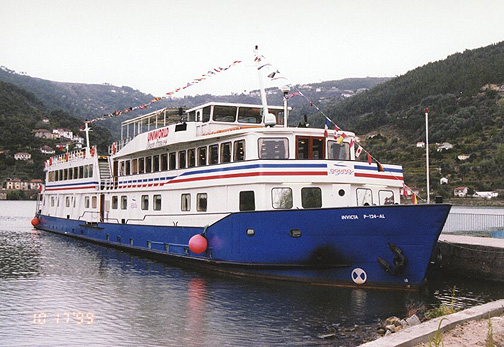
the Douro Princess
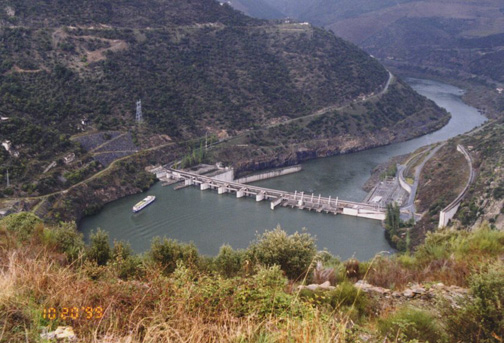
took us through the locks in the dams
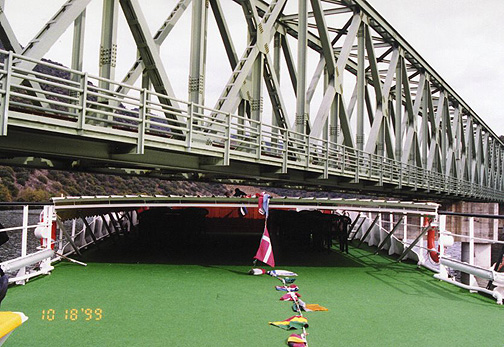
and under
the low bridge
(the ship's bridge roof and the upper deck canopy had to be lowered)
![]()
On the Cruise we learned
The story of PORT WINE
For thousands of years, foreign aficionados have cherished the wine that is grown in northeast Portugal on the mountainsides along the Douro River. As far back as the first century B.C., the Greek historian, Polybius, in his Land of Wine, noted that this wine sold at one draclima for a matreta (27 liters). At the time of the Caesars, the Romans, who occupied the region, introduced treading troughs and clay amphoras for making and aging the wine. Viticylture became so popular that the Emperor Domitiaii had to order the number of vineyards reduced by half to keep a balance with other agricultural products.
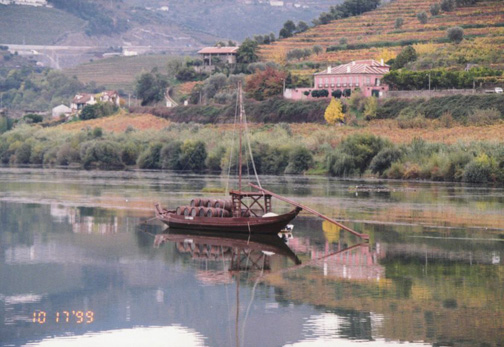
Barco Ralelos used to transport Port wine down the river in front of vineyard slope
Wine Cultivation thrived during the Visagoth domination and survived the Moorish occupation of the 8th to 12th centuries. From 1143, when Portugal became an independent kingdom, Douro wine was often mentioned in royal decrees, and by the 13th century it was shipped down the Douro River to the coastal town of Porto, and exported as far afield as Holland.
The Portuguese historian, joão de
Barros, in his Geografia of 1 548, cites the quality of various wine locations
from one end of the Douro to the other, enthusing that wonderful wines are
harvested in the Douro, whence they are shipped to the city of Porto.o. By the beginning of the 17th
century as many as 1,200,000 cases reached Porto each year, and in 1638 a German
diplomat named Cristiano Kopke founded a Douro wine shipping company that is
still in existence today. In 1675 wine destined for Holland was called for the
first time by its modern name: Porto. Although, by law, only wine produced in
Portugal may be called Porto, other countries accept and respect its translation
(Port or Port Wine).
THE
BRITISH DISCOVERER There was a
flourishing English colony in the city of Viana do Castelo, 50 miles north
of Porto, in the early 1 7th century. There, British merchants imported
woolen goods from England, and exported agricultural products and a light,
crisp coastal wine now called "Red Vinho Verde." Not popular with
the British gentry, it was used as "sailors rations." vineyards in
the mist When political
problems arose between France and England in the 1660s, Bordeaux, the wine
of choice of the well-bred Englishman, became virtually impossible to
obtain. The Viana merchants tried to market their "sailor" wine as
a substitute, but in vain. They next proffered the richer, more aromatic
Porto wines from the Douro and met with such success, that they changed the
center of their activities to the town of Porto. The first English Porto
firm was Warre in 1 670, followed by Croft, Quales-Harris and, by the end of
the century, Taylor-Fladgate. Many others were founded in subsequent
centuries. Barco Rabelo in
front of Wine House Porto became
the favorite wine of the Whig party and in 1689, in the presence of
Catherine of Braganza, the Portuguese widow of Charles II. Porto
was used to toast William and Mary at their coronation. Dr.
Samuel Johnson subsequently claimed that "Claret is the liquor for
boys, and Port for men" and John Croft that "any Englishman of
decent condition... cannot dispense with it .... " wine producer In 1678, the
earliest year from which export records exist, there were 24,000 cases of
Porto shipped to England; in 1693 780,000, escalating to 1,500,000 by 1728.
The English had taken a new wine to their hearts. Story of wine
in Portuguese tile This rapid rise
in popularity led to abuses and falsifications until in the 1740s, to meet
demand, growers and shippers were adding elderberry juice and wines from
distant regions to the pure product. A consequent loss in quality caused a
loss in demand, and the number of cases shipped plummeted to 750,000 by the
end of the decade. This prompted the Portuguese authorities, in 1756, to
found a "Companhia Geral da Agricultura dos Vinhos do Alto Douro",
to control all aspects of production. The exact boundaries of the Douro
region, and strict regulations to insure the authenticity of the wine, were
set by 1761. These pioneering measures led to unprecedented quality control,
and provided a model for the demarcation of wine regions in other countries.
Shipments to England consequently rose to a spectacular 3,500,000 cases by
Story
of wine in Portuguese tile Today, control
is better than ever. The Porto Wine Institute in Porto, and the Casa do
Douro in Régua, both founded in 1933, oversee every aspect from the vine to
the consumer. Story
of wine in Portuguese tile Ironically, the
French, who were indirectly responsible for the English infatuation with
Porto, in the late 20th century drink three times as much Porto as the
English - more than any other nation. Return
to Elderhostel in Portugal page Return
to Portugal Country page
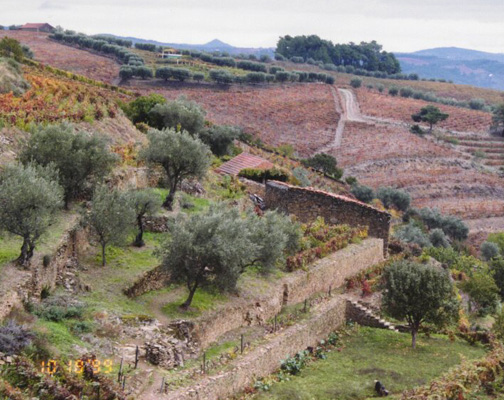
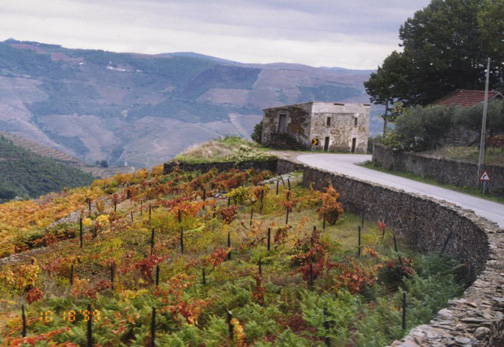
PORTO WINE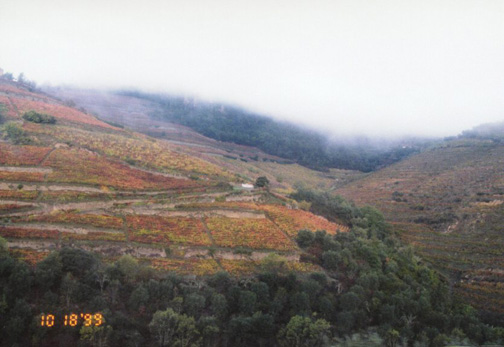
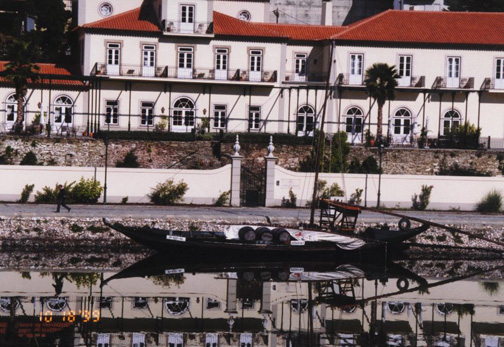
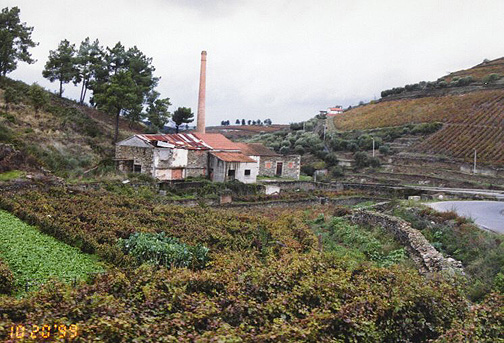
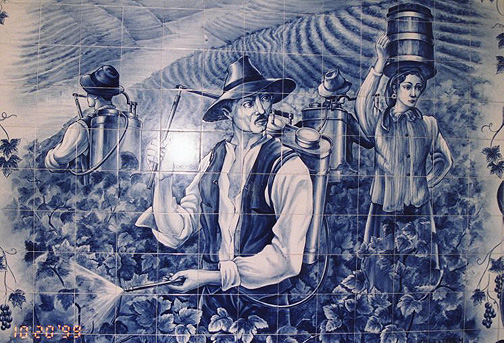
(spraying the vines)
1799.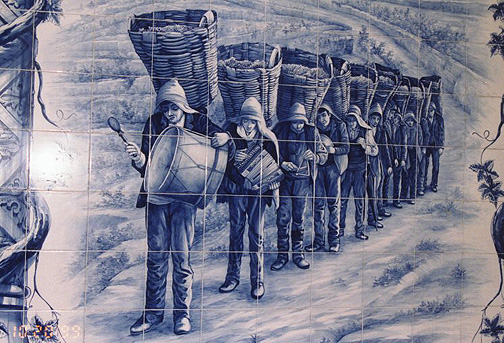
(carrying the grapes to be crushed)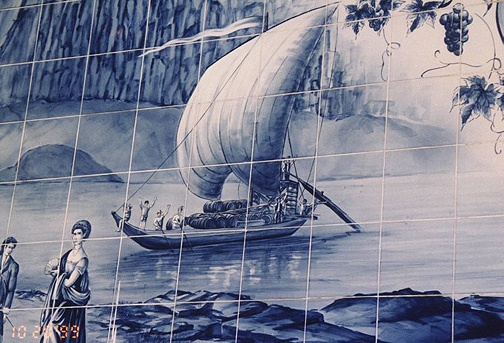
(port wine going to Porto by boat)![]()
![]()